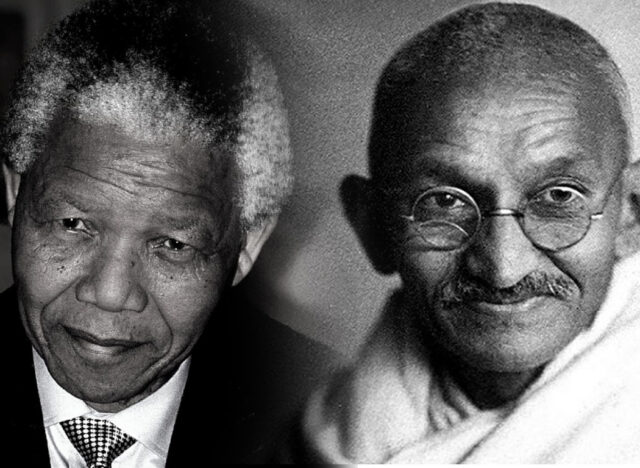Mandela led a peaceful campaign after his release from prison, with an emphasis on reconciliation and a unique approach to forgiving the enemy. Mandela learned the essential virtues of forgiveness and compassion from Gandhiji and adopted them after he assumed power as the first President of an apartheid-free South Africa.
Nelson Mandela was, in many ways during his lifetime, a practitioner of Mahatma Gandhi’s philosophy of Satyagraha, or Truth Force, passive resistance, and Ahimsa, or non-violence. Mandela referred to Gandhiji as his role model, was inspired by Gandhiji to lead South Africa’s journey to independence, and was sometimes referred to as the ‘Gandhi of South Africa’. While Mandela and Gandhiji never met, both were linked by a passion to end oppression and bring about change and took up the cause of their respective colonised countries and their subjugated people, inspiring them to resist oppression. Gandhiji’s philosophy and approach left an indelible mark on Mandela and shaped his sociopolitical journey in South Africa. Though we cannot compare Mandela and Gandhiji, some of the similarities between the two leaders include Gandhiji’s emphasis on moral power as a force to be reckoned with and Mandela’s belief in the power of moral uprightness. Both were lawyers who spent time in jail in Johannesburg’s Old Fort prison (Gandhiji in 1906 and Mandela in 1962). It is said that it was during Mandela’s 27-year prison term on Robben Island, where the room was full of books by Gandhiji and other classics, spent in meditation and reflection, that the bitterness left his soul. Mandela and Gandhiji shared the conviction that all marginalised people, whatever their religion, ethnicity, or caste, must stand together.
It is an interesting coincidence that these two most prominent and inspirational world leaders had a connection with South Africa. Mahatma Gandhi’s journey to becoming a Mahatma (or great soul) began in South Africa and saw him being transformed from an ordinary subject of the British empire to a charismatic leader of the largely peaceful, nonviolent Indian independence movement. Through his philosophy and convictions, Gandhiji challenged the legitimacy of British rule in India and South Africa under the apartheid regime, following largely non-violent, non-cooperation protests.
Was Mandela a Gandhian? It is not easy to answer this, but the special, almost umbilical, bond between Mandela and Gandhiji was very real. Mandela was more a symbol of unity than of non-violence. Mandela studied Gandhi’s methods of non-violent resistance in college, was expelled for participating in a non-violent student protest movement, and may have been disillusioned with the efficacy of non-violence. Mandela founded the ‘Umkhonto we Sizwe (Spear of the Nation), the military arm of the African National Congress (ANC), in 1961, after the Sharpville massacre, inspired at that time by Fidel Castro of Cuba. He was of the view that it was not possible to be non-violent when the apartheid government responded with force and violence, especially as, in his words, ‘the government had left us with no other choice.’ This marked his move from passive to armed resistance.
Gandhiji, on the other hand, was of the view that only non-violent protest could transform the minds of the oppressors. At the same time, Gandhiji did not abjure violence all together and said where the choice is between cowardice and violence, he would advise the use of violence. Mandela considered Gandhiji one of his teachers and said that he called for non-violent protest for as long as it was effective. Over time, Mandela evolved from being in favour of the use of arms and force to oust the colonial apartheid rulers to adopting a more non-violent approach after he understood the power of non-violence and the futility of violence, which would impoverish everyone materially, culturally, and spiritually.
Mandela led a peaceful campaign after his release from prison, with an emphasis on reconciliation and a unique approach of forgiving the enemy. Mandela learned the essential virtues of forgiveness and compassion from Gandhiji and adopted them after he assumed power as the first President of an apartheid-free South Africa from May 10, 1994, until June 29, 1999. He created an inclusive government of national unity, in which F. W. de Clerk, the last apartheid-era president, became the deputy president, making South Africa a multi-ethnic and multiracial, inclusive country—a rainbow nation of peace and harmony. The Truth and Reconciliation Commission, an innovative experiment by Mandela, brought together those accused of rapes, bombings, and assassinations with their victims and families to testify before the Commission and seek forgiveness from the victims and families.
Mandela shared a strong connection with Gandhiji and India and stressed that in a world driven by strife, Gandhiji’s message of peace and non-violence held the key to human survival in the 21st century.









